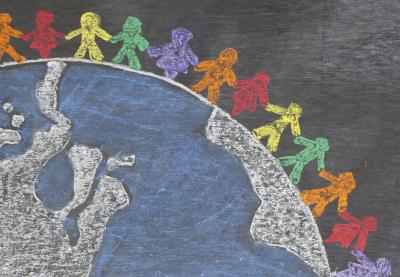Editor's note: This article has been updated to reflect the 2018 anniversary of the Universal Declaration of Human Rights. For more resources on teaching about the UDHR, visit the HRE USA website or explore the United Nations' #standup4humanrights campaign.
December 10, 2018, marks the 70th anniversary of the Universal Declaration of Human Rights or UDHR. (You can find a student-friendly version of the UDHR here.) Drafted over the course of two years by a committee composed of chairwoman Eleanor Roosevelt and eighteen other members representing diverse nationalities and beliefs, this document represented the world’s commitment—in the wake of World War II—to the protection of individual human rights.
Although my teaching career has led me to two states and two continents, many of the curricular requirements I encountered were the same. For example, I was expected to use The Diary of Anne Frank and other Holocaust literature with my eighth-graders.
Every English or social studies teacher who has taught the European Holocaust knows what a range of texts is available on this topic, including memoirs, autobiographies, picture books, news clippings, photographs and historical documents. Where would I start? What would I include? I knew I didn’t want to encourage the “I feel so bad for them” syndrome that can result from studying this content. I wanted to provide varying perspectives of the stories told and sufficient context to encourage my students to connect these stories to present-day struggles—without minimizing the tragedies of war—and to foster students’ desire to work toward a just society.
I decided to start with the end. I asked myself, “What do I want my students to know and do?” This led to questions like these:
- What does it mean to survive?
- How can an individual make a difference during wartime?
- Is it ever OK to make another person suffer?
- What is required to stand up for another person?
- When is it OK to stand up to authority?
These are enduring questions that don’t rely on a specific text or time period; they can be discussed for years to come. I posted these questions around the room, and they drove my planning.
I investigated the literature in the same way—beginning with the end. Instead of diving into the range of literature available, we started with the Universal Declaration of Human Rights, a document created as a consequence of the atrocities committed by Nazi Germany during World War II.
My students and I closely read the preamble together and identified and defined some of the difficult vocabulary found in the UDHR: tyranny, oppression, jurisdiction, inalienable, dignity, equity. We split the 30 articles of the UDHR among groups of two or three students. The groups were tasked with understanding the assigned articles and preparing a one-minute explanation for the rest of us. Some groups acted out the assigned articles; others enjoyed the opportunity to lead the class in lecture. I circulated and facilitated the small group discussions, guiding students to closely read each article in an effort to fully comprehend the text. I also recorded student comments.
After closely reading and investigating the UDHR and revisiting our big questions, I asked students to create their own big questions, using what they had learned. They came up with questions like these:
- What are rights?
- How are rights decided?
- Who makes sure governments respect the articles of the UDHR?
- Are all 30 articles of the UDHR being met in our community?
We posted these questions around the room.
Then we dove into the texts. We read The Diary of Anne Frank by Anne Frank, Milkweed by Jerry Spinelli, The Devil’s Arithmetic by Jane Yolen, Anne Frank: The Biography by Melissa Müller, Night by Elie Wiesel and Soldier Boys by Dean Hughes, as well as poetry, magazine and newspaper articles, films and photographs from World War II.
We examined each text through the UDHR lens and asked:
- Are human rights violated in this work? How?
- Are human rights defended in this work? How?
- What does this text say about individual responsibility for human rights?
- What action is taken in this work to uphold human rights?
- Which characters do not act to defend human rights? Why not?
In larger class discussions about these texts, we identified how compassion, teamwork, privilege, empathy, collaboration and silence hindered or helped to uphold human rights. Throughout the remainder of the year, we added to our bank of big questions related to the UDHR, applying them to the texts we read and to our own community.
Closely reading the UDHR and applying our learning through the lens of the big questions allowed students to arrive at their own nuanced understanding about human rights. They took ownership of the ideas inherent in the document, and that ownership drove their learning. My students may not remember every detail of what they read about World War II, but they practiced linking the primary concepts across multiple types of writing and disciplines, and that practice reinforced not only their knowledge but also their critical reading and thinking skills. By starting at the end, I was able to give my students the keys they needed to unlock one of the most painful and complex periods in recent history.
Wicht is an equity and diversity trainer and the founder of Wicht Consulting.
